Saintpaulia, also known as indoor violet, is a very popular flower that cannot be missed on the windowsills of enthusiastic gardeners. In the apartments and houses, a beautifully flowering herbaceous plant of the Gesneriaceae family, which won worldwide recognition in a short time, came from East Africa.
Material Content:
Description of popular varieties
Indoor, or uzambara violet, is a low-growing evergreen perennial consisting of a shortened stem and a basal rosette of leaves, which are covered with a small fluff. The color of the leathery plates in plants of boys is uniformly green, and in girls - with a bright spot near the heart-shaped base. If you provide all the necessary conditions, then blooming, in which flowers bloom with a wide color palette, can be observed almost year-round.
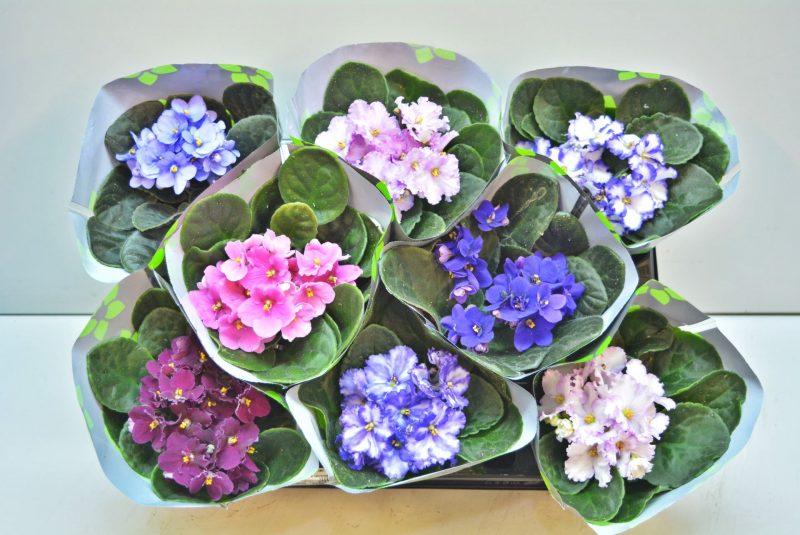
In the wild, the senpolia is represented by 20 species, on the basis of which about 35 thousand varieties were bred.
Popular varietal and hybrid violets:
- "Caprice" - is distinguished by snow-white terry flowers, decorated at the edges with a fringe of green color, and variegated, fleecy leaves.
- "Macho" - a purple variety, semi-double flowers which stand out with a white border.
- “Your Majesty” is a contrasting variety represented by plants with bright pink flowers and saturated green leaves.
- “Sea Wolf” - is distinguished by very large flowers of blue color, decorated with a thin net.
- “Water” is a terry variety with medium-diameter flowers, consisting of petals of a blue color, which changes to pink at the edges.
- “Tomahawk” is a bright red variety, distinguished by abundant flowering.
- “Paris Secrets” - a variety with terry flowers of dark purple color, bordered by green ruffle. Variegated leaves.
- “Max Black Pearl” is a black Saintpaulia with velvet flowers casting purple.
Optimal conditions for growing
For the senpolia, so that it delights with its abundant and beautiful flowering throughout almost the whole year, it is required to ensure optimal conditions of detention.
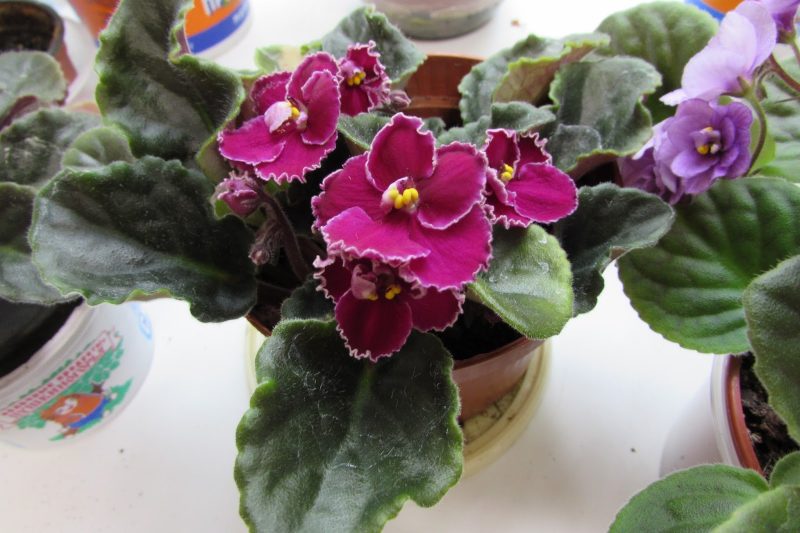
- Ground and pot requirements. The abundant bloom of the senpolia is noted only after its development by the roots of the entire earthly coma. Therefore, it is important to choose the right pot, which should not be too large. When choosing the capacity, you can calculate the required diameter by dividing the same indicator of the leaf outlet by 3. In nature, the senpolia grows on loose, slightly acidic soils that quickly pass air and water. To prepare a substrate with similar indicators at home, it is enough to mix turf, leafy soil, sand and humus in a ratio of ½: 2: 1: 1.
Advice! To increase the fertility of the substrate and stimulate intense flowering, a little superphosphate should be added to the soil mixture.
- Location and lighting. Saintpolis need a lot of soft light that will fall on the shoots for 13-14 hours. It is recommended to install a flower pot on the north-east and north-west windows to protect the plant from getting burns due to scorching sunlight. In winter, it is necessary to organize additional lighting.
- Humidity. For violets, an increased level of humidity is provided, which the crop is in great need of. A container with water or wet pebbles is installed next to the pot.
- Temperature mode. Senpolia is a thermophilic crop for which a temperature drop below 15 ° C is critical. Optimum temperature values range from 18 to 24 ° C.
Care for the uzambar violet at home
In order for the flower to caress its eyes with beautiful flowering even on cold winter days, it is necessary to carry out comprehensive care of the senpolia in compliance with all agrotechnical requirements.
More materials:violet - home care
Watering and spraying flowers
To moisten the senpolia, which reacts sharply to stagnation of water in the roots, it is recommended to use a lower watering system, in which the pot is immersed in a bowl of warm, settled water almost to the edges and removed after the surface of the substrate shines from moisture. The signal for the next procedure is an almost dry earthen lump.
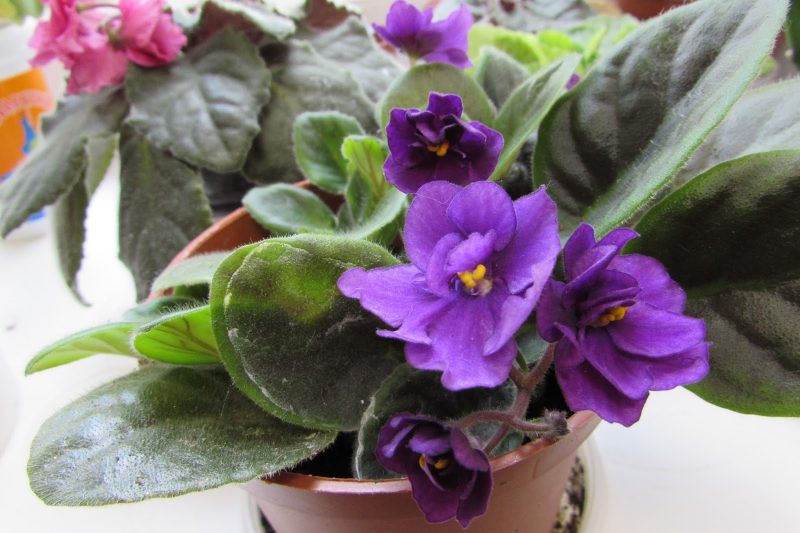
Important! Despite the need for moist air, it is not recommended to spray Saintpaulia: drops of water can become a magnifying glass through which even the diffused sun can burn the shoots of the plant.
Fertilizer and fertilizer
An important component of the comprehensive care of violets is weekly top dressing during the growing season.

To enrich the soil, liquid mineral fertilizers are used for flowering plants with a reduced dosage of 2 times.
How to care after flowering
When the flower of Saintpaulia has blossomed, all dried inflorescences should be removed. In addition to dried flowers, leaves that are located below the third tier, as well as yellowed and deformed, are removed.
Plant transplantation and rejuvenation

Saintpaulia transplanted annually in early spring, when:
- A drainage is placed in the pot for better passage of water and air.
- A layer of drainage material is covered with a nutritious soil mixture.
- Then violet with an old earthen lump is gently rolled over.
- The free space is carefully filled with fresh substrate.
- After the transplant, the violet is well moistened.
In the process of development, the lower leaves are removed from the senpolia, which over time leads to exposure and extension of the stem. To rejuvenate the bush and return it to its former decorativeness, you should cut the outlet with a small part of the hemp and put it in the water for rooting. After the formation of roots, the plant is planted in a permanent pot.
Important! Breeding of Saintpaulia by children is carried out simultaneously with a plant transplant.
Protection against diseases and pests
A native of Africa can be affected by fungal diseases - powdery mildew, fusarium infection, late blight, rust and gray rot. Diseases most often develop in conditions of excessive watering or excessively high humidity. In order to cure a plant affected by infection, it is recommended to resort to the treatment of shoots with a fungicidal preparation according to the manufacturer's instructions. In the case of gray rot, it is worth first transplanting the violet into a fresh substrate.
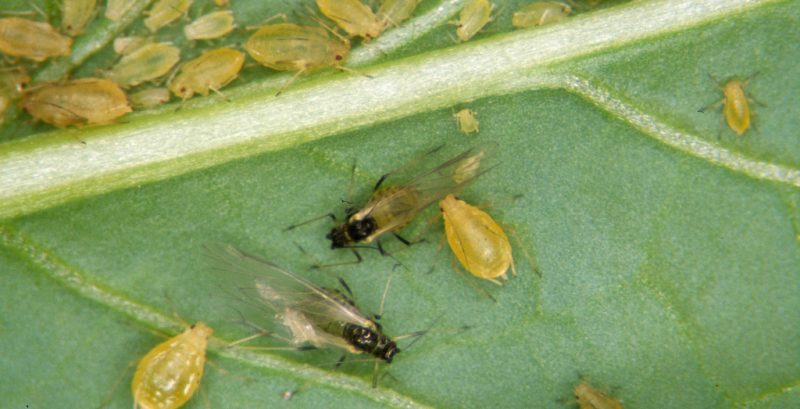
Of the pests on the violet of Uzambara, you can see ticks, aphids, thrips and worms that inhabit shoots in dry air. An insecticidal solution is used to combat them. With excessive moisture, the senpolia can become home to flies whose larvae destroy the substrate, making it less breathable. To get rid of insects, you can use "Dichlorvos".
Breeding Saintpaulia
You can save varietal traits and propagate the charming senpolia using vegetative methods.
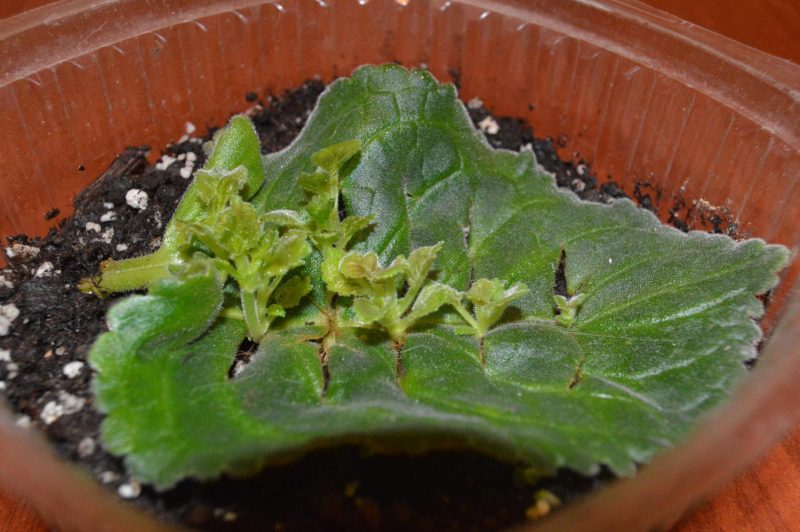
When the bush has formed several outlets, you can separate the children when transplanting.
During:
- The violet is carefully removed from the pot.
- The roots of the maternal instance and the children are separated.
- Children sit in individual pots filled with nutritious soil mixture.
A very simple way to get a new plant is propagation by a leaf that is selected from 2 tiers and placed in water. After the appearance of the roots, the plant is planted in a nutrient substrate. Rooting can be carried out directly in the tank with the soil mixture, which is covered with a cap to create greenhouse conditions.
What problems can flower growers face?
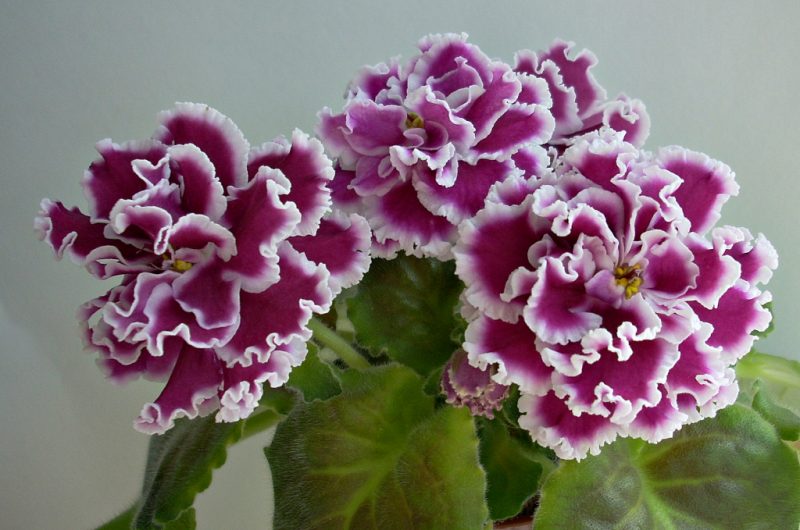
When growing violets, gardeners sometimes have problems:
- The violet does not bloom. The reason for the lack of flowers may be due to a lack of light, an excess of nitrogen in the substrate, an overly spacious pot, violation of the irrigation regime and too low a level of humidity.
- Senpolia turns yellow. The problem situation may be due to the improper position of the pot and direct sunlight on the shoots, as well as to a lack of nitrogen, colonization of the senpolia by sucking pests, excessive watering, leading to the development of rot, or simply with the natural aging process.
Thus, the abundantly blooming senpolia, which, by the way, has no affinity with the garden violet, is a charming plant that gives flowers to the gardener all year round with a very short rest period.












